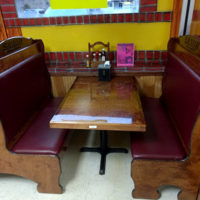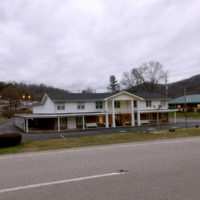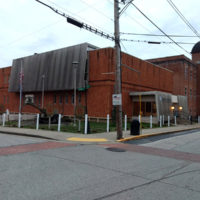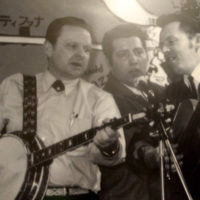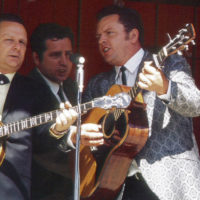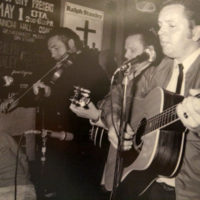
In late January, my wife and I made our way to Jackson, Kentucky. I wanted to get to the bottom of what really happened the morning of May 2, 1974, and dispel what I knew were mistruths in a 2003 publication on Roy Lee Centers’ murder. The iconic bluegrass vocalist lost his life before age 30, just as he was beginning what would have been a storied career.
With much attention lately on some of Ralph Stanley’s lead singers, we should not forget one of the best, and I wanted to do this in his memory. I was warned about getting involved in this, but when a man has been lied about, and stories twisted, it is time for the truth to come forward. We met with Roy Lee’s son, Lennie Centers, and his wife, Joan, at their home, and got all this information from someone who was there, who lived it.
In this article we will share never before published pictures of Roy, crime scene pictures as they are today, and video footage from the actual crime scene. Pictures from the 1971 Japan tour are courtesy of Kosuke Hirai and the Centers family. Lennie was kind enough to run around Breathitt County with us, and take us to places involved on the night of the murder.
Roy Lee Centers was a gentle soul, who never went looking for trouble. Well loved in Jackson and throughout the world, he always got along with everyone. He studiously avoided confrontation unless he felt threatened. Even with everything that happened on that fateful night, Roy showed mercy to the man who took his life. All accounts in this article are from Lennie himself, or from courthouse documents. I can’t quite explain to you all my feelings while talking to Lennie, a gracious, mild mannered man, who at 12 years old, witnessed his fathers execution. We are all wound differently; some would be bitter, angry, and hateful, but Lennie rose above it. Does he forgive Billy Hurst? That’s an answer for Lennie to give, but he didn’t let it change his kind heart. He got it from his dad, and that’s something that can never be taken away.
Roy Lee Centers was born November 8, 1944 in Jackson, Kentucky. Breathitt County was steeped in tradition. Known for bluegrass music, beautiful countryside, and also family scuffles and sometimes lawlessness. I would like everyone to know, that as I worked on this article, it dawned on me that some things in this piece may seem graphic due to the nature of Roy Lee’s passing, but I can assure you I’m writing this only to preserve his legacy, and to consolidate the history of the events leading to his untimely passing.
In the early 1960s, Roy Lee and his wife Lucille relocated their family to the Dayton, Ohio area. Roy Lee started performing with Jack Lynch, Fred Spencer, and other well-known Dayton bluegrass pickers. They formed a band called The Lee Brothers and The Miami Valley Boys, and started performing in Tom’s Tavern and other Dayton east side nightclubs. It was November 1969 when Ralph Stanley contacted him for the lead singing position with The Clinch Mountain Boys following Larry Sparks’ departure.
Shortly after joining, Roy Lee moved his family back to Jackson. He would receive a weekly salary from Ralph of $100. I have often heard rumors that Ralph was aware of the eerie similarities between Roy Lee and Carter Stanley’s singing at the time of Carter’s death, but that it would have been too hard on Ralph to stand next to someone that reminded him so much of his brother at the time. I had the great honor of playing lead guitar with Ralph on a few shows in 1990. On one such occasion when I had not brought a suit jacket with me, Ralph went to the back of the bus and brought me a blue jacket that he claimed had belonged to Roy Lee. We got into conversation about how much Roy Lee reminded him of Carter. He said even the way that he drank coffee and smoked a cigarette was reminiscent of Carter.
Roy Lee Centers recorded some of the finest material with Ralph, post Carter Stanley. He had a powerful rhythm and as smooth of a lead voice as could be heard. A few weeks prior to his death, Roy Lee had approached Jack Lynch about producing and recording some records for him. Many believe Roy Lee was about to leave Ralph and go out on his own, but these were just rumors. Ralph and the boys had just returned from a California tour, and on May 1, 1974, Roy was at home. Earlier that week, Ralph had picked Roy up at his home and they drove to Lexington and got on a plane to California. When they returned, Ralph dropped Roy off at home, and that would be the last time Ralph saw Roy alive.
Roy Lee’s final show with Ralph Stanley – April 28, 1974
When his son Lennie got home from school that day, they played baseball in the yard. That evening Roy and his brother, Daniel, went next door to do some recording. Roy had declined an offer earlier in the day to attend a house party that some friends were having. Around 10:00 p.m. a couple of Roy’s friends showed up at the house and urged him to come to the party. Not wanting to hurt anyone’s feelings, Roy and his 12 year old son Lennie loaded the Martin guitar that Roy had just purchased from Keith Whitley, and a banjo into his 1963 Chevy Nova.
From all accounts, Billy Hurst was not a nice person. Lennie recalled in grade school, Billy would make fun of less fortunate kids. His mom had money and Lennie recalled him as a spoiled rich kid who was a bully. From everything I gathered, this whole incident revolved around Billy Hurst being jealous of Roy, his talent, and the attention he received. Lennie described him best as the character on Dallas, J.R. Ewing.
Reports in earlier publications stated that while they were out in California, Roy Lee had purchased he and his wife, Lucille, brown leather fringe jackets. This was partly false. The jackets were purchased on a trip to New Mexico in 1974. Roy was wearing this coat on the night of the murder. As an example of Hurst’s demeanor, he approached Roy at a party months before and asked where he got the coats. Roy explained that he got them in New Mexico, and paid $20 a piece for them. Hurst went out and bought 2 identical jackets and made sure he announced loud and clear at the next gathering that his coats were better, and they cost $175. The coat Roy was wearing that night was taken without permission from Lucille. It was taken by her brother, and given to Bob Chapman, who later sold it to the International Bluegrass Museum in Owensboro for $500. It was later discovered that $200 dollars was stolen from Roy’s jacket.
Attending the party that night were Billy Hurst, and Billy’s girlfriend, Geraldine. Around 1:00 a.m. a scuffle broke out at the party. A man named Donnie had told local musician, Sam Wilson, that he couldn’t sing. Hurst went to swing at Wilson but missed, hitting him in the chest instead of the face. They fought for a bit, but it soon cooled off. This was after Hurst was instigating a fight earlier in the evening. Sam Wilson was denied the right to testify at the trial where Hurst was charged with murder.
Around 2:00 a.m., Roy and Lennie left the party, and Roy soon realized his car was almost out of gas. During that time President Nixon had put a limit on the amount of gas you could buy during the first Gulf oil crisis. Lennie recalled Ralph, a staunch Democrat, mumbling under his breath many times about having to stop the bus constantly because you could only purchase so much gas at a single station.
Roy pulled into Billy Hurst’s house. Court records show that Roy was in the house 30 to 40 minutes, and no one but Roy, Billy, and Geraldine knows what happened behind those walls, but something went awry. Rumors that Roy made advances on Geraldine were unfounded. Roy told people many times he thought Geraldine was unattractive, and lets be real, why would Roy Lee, who had a beautiful wife at home, make advances to a woman whose boyfriend was in the same room?
Lennie was in the car half asleep, and soon saw his dad running out of the house. Billy and Geraldine came out, with Billy firing a gun. Billy Hurst was a bonded deputy. Roy Lee went to the road, and Billy told Geraldine to get Lennie and put him in his truck. They pulled out onto the road, and when the headlights shown on Roy Lee, Billy told him he was under arrest and to get into the truck.
A scuffle ensued inside the truck. Billy Hurst kept hitting Roy Lee with his .38 caliber pistol. A report in a 2003 publication said Roy Lee told Billy Hurst “stop hitting me you’re going to knock my eyeball out of my head.” There is no proof of this, and Lennie said that was completely false. Billy Hurst was wearing a big diamond ring, and coroner Frank Fletcher did testify that during the beating the ring had burst Roy’s eyeball. In the 2003 report, the writers claimed they were headed to Elkatawah, an isolated dead end road. False as well. The article also got the name of the road wrong. They reported Townbranch Road, but it was Town Line Road. Prior publications also reported a snub nose .38, also false. It was a 6 inch barrel .38. Nevertheless, Roy knew this was not going to end well.
At some point on the way Roy grabbed the steering wheel, stepped on the gas, and caused the truck to go over an embankment into Cane Creek, right in front of Denver McKnight’s house. Lennie recalled his Dad seeing a street light, and thinking this would be a good place to upset the truck, hoping someone would come out to see what the ruckus was. Lennie believes that his dad was worried Billy was going to kill them both, and was trying to give his son an opportunity to run. After the truck wrecked in Cane Creek, Geraldine ran to Denver McKnight’s house. Lennie climbed up the bank to the road. He recalled Roy and Billy fighting on the creek. Roy had knocked Billy down and had him by the neck holding him under the water. Lennie remembered seeing bubbles coming from the water, then Roy let him up to get air.
Even under the threat of a drunk madman, Roy showed mercy. Roy got up and sat on a rock in the Creek, trying to gather himself. It was then that he was shot. Roy Lee had been shot and pistol-whipped in Cane Creek off of Town Line Road. Roy was shot three times, once in the leg above the knee and twice in the face, and pistol-whipped. According to the autopsy, he had succumbed to blunt force trauma to the head. He was pistol-whipped so badly, the gun would no longer fire. Despite rumors of a shootout, Roy Lee Centers was unarmed. On May 2, 1974, at 29 years old, Roy Lee Centers passed away face down in Cane Creek. During the funeral, Lennie noticed a piece of flesh on his father’s right pinky missing. We believe that this is where the first shot was fired at Billy Hurst’s house.
Rumors stirred about the funeral. Some had said Ralph paid for the wake and burial. This is also false. Ralph did, however, offer to have Roy taken to the Hills of Home Stanley family cemetery and offered to pay for the burial. The family declined as they wanted him close to home. Here is the truth. After Roy Lee’s murder, Bobby Osborne approached Lucille and said he wanted to help. He explained to Lucille that the times that Ralph had performed on the Grand Ole Opry, Ralph had payed into a trust for circumstances such as this. The entire funeral was paid for by the trust.
A trial was held in Jackson County. Many believe Billy Hurst was connected politically in Breathitt County. He served only 34 days for the murder and claimed self-defense. 12 year old Lennie testified, but was instructed to answer either yes or no to questioning. No testimony of events would be allowed by him. Are you convinced of corruption yet? Hurst was released on shock probation. A funeral was held in Jackson, Kentucky, where Roy’s body lay in wake for two days, while thousands passed to pay their respects. In attendance were Ralph, his wife, Jimmie, Keith Whitley, and Keith’s mom and dad, Elmer, and Faye Whitley. After the funeral, the five of them met at a diner in Jackson for lunch, the Country Inn. During lunch, Ralph and Elmer were discussing what Ralph was going to do for a lead singer. Elmer looked at Keith and said, “I think I might know a feller who is interested.”
The family had planned on filing a civil suit against the Hurst family. Ricky Skaggs approached the Centers family about getting a high powered attorney out of Washington, DC. Lucille was told she had to use an attorney within the county of Breathitt. More hogwash and political corruption. A suit was never filed and despite reports in a 2003 publication that the family had received $25,000-$50,000, the family only received $10,000 in a civil settlement. Two years after the murder, when Lucille received death threats to herself and her children, she moved, relocating to neighboring Wolfe County.
Billy Hurst had three sons. They all have become upstanding men. They were raised by their mother and grandparents, and kept from the wrath of Billy Hurst. One is a preacher. In one instance, one of the boys had a banjo that Lennie’s son, Roy loved. The young man gave it to Lennie’s son. The Centers family have made peace with Billy’s boys.
There are many more details and rumors surrounding Roy’s passing. Lennie Centers and Teresa Cress are in the process of writing a book about Roy Lee’s life and death. I only included highlights to protect the family’s privacy, and to preserve what I believe is the legacy of one of the greatest lead singers bluegrass has ever known, Roy Lee Centers.



